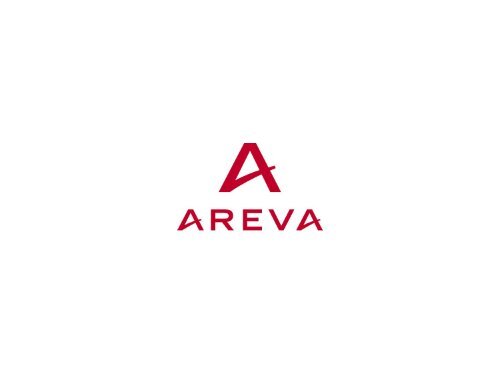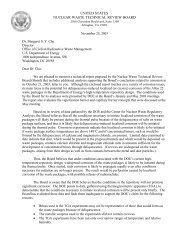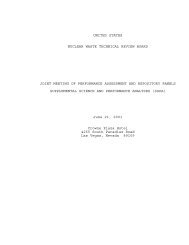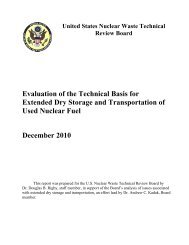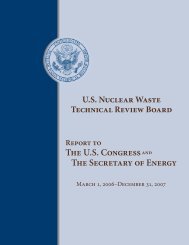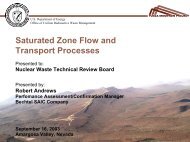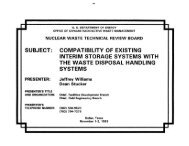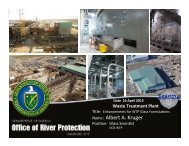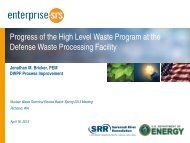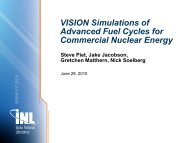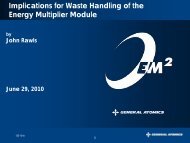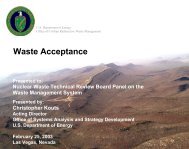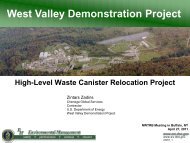Dorothy Davidson - US Nuclear Waste Technical Review Board
Dorothy Davidson - US Nuclear Waste Technical Review Board
Dorothy Davidson - US Nuclear Waste Technical Review Board
You also want an ePaper? Increase the reach of your titles
YUMPU automatically turns print PDFs into web optimized ePapers that Google loves.
<strong>Waste</strong> Generated<br />
from Recycling<br />
of Used <strong>Nuclear</strong> Fuel<br />
<strong>Dorothy</strong> <strong>Davidson</strong>, Ph.D.<br />
VP Strategic Programs, AFS LLC<br />
U.S. NUCLEAR WASTE TECHNICAL<br />
REVIEW BOARD MEETING<br />
NATIONAL HARBOR–SEPTEMBER 23, 2009
International <strong>Nuclear</strong> Recycling Alliance<br />
(INRA)<br />
Should U.S. consider<br />
recycling?<br />
• Recycling makes sense,<br />
especially if it can be<br />
financed through the<br />
NWF<br />
• Responsibility for an<br />
integrated nuclear waste<br />
management strategy for<br />
the U.S. should be<br />
transferred to a new<br />
government entity<br />
What is required for private<br />
financing?<br />
• Commercial model with<br />
existing fleet<br />
(e.g., LWR recycling)<br />
• Investment grade<br />
with guarantees<br />
(e.g., proven technology)<br />
• Rulemaking<br />
(one-step licensing)<br />
NWTRB Meeting – September 23, 2009 – Page 3
Study Results based on<br />
Technology Readiness and Business Plan<br />
Consolidated Recycling Facility (CRF)<br />
Sodium Fast Reactor (SFR)<br />
Note: Adapted from “JAEA-<br />
Research 2006-042”, Fig<br />
2.1.1-4, p. 69 (2006)<br />
Commercially available<br />
Based on state-of-the-art, proven<br />
(50 years) technology/experience<br />
La Hague/Melox, Rokkasho, Thorp<br />
COEX TM process - no pure plutonium<br />
stream<br />
Co-location of separation and fuel<br />
fabrication<br />
Capacity based on market for recycled fuel<br />
Flexible to allow deployment of new<br />
technology<br />
Commercial Demo Required<br />
Existing roadmap for commercializing fast<br />
reactors in Japan provides a solid foundation<br />
• Based on technology/experience from<br />
JOYO, MONJU, Phenix, SuperPhenix<br />
• R&D required to make commercial design<br />
cost-competitive and enhance reliability<br />
and safety<br />
Start with oxide fuel but can burn metal fuel<br />
Homogeneous or target transmutation fuel<br />
NWTRB Meeting – September 23, 2009 – Page 4
Recycling Experience<br />
Pre-conceptual design of the initial <strong>US</strong> Facility based on proven<br />
state-of-the-art processes and technologies from France, UK and<br />
Japan (50 years of commercial experience and continuous<br />
improvements)<br />
to mitigate the risks (schedule, costs, licensing, safety)<br />
to guarantee process efficiency and technology reliability<br />
to minimize the impact on the environment<br />
to allow flexibility (evolutions of the plant during operation)<br />
NWTRB Meeting – September 23, 2009 – Page 5
Assumptions for<br />
Closed Fuel Recycling Studies<br />
<strong>Technical</strong><br />
Geological Repository - Yucca Mountain<br />
Reference fuel: PWR fuel – 50 GWd/t – 4 years cooling time for<br />
maximum benefit to repository (reduced Am, therefore, Np<br />
content)<br />
Treatment of UNF of any burn-up (UOx and MOX) from LWR<br />
possible<br />
No pure Pu stream and mature technologies to reduce risk<br />
Fabrication of LWR and SFR MOX fuels<br />
Advanced processes to be implemented when mature, working<br />
with National Labs to develop and implement<br />
Business<br />
Commercial facility<br />
NWTRB Meeting – September 23, 2009 – Page 6
Recycling Scenarios<br />
Commercial Scalable<br />
Reference Design<br />
COEX TM process<br />
Any burn-up/age UNF<br />
FP and MA in glass<br />
LWR and SFR fuel fabrication<br />
Evolutions<br />
Capacity increase (800 to 2,500<br />
Mt/y)<br />
Advanced MA separation when<br />
mature<br />
Transmutation fuel fabrication<br />
Homogeneous / heterogeneous<br />
Advanced<br />
separations<br />
COEX TM<br />
100 800<br />
2,500<br />
CRF capacity (tons/yr)<br />
(1): Demonstration<br />
(2): Commercial scalable<br />
NWTRB Meeting – September 23, 2009 – Page 7
Process Diagram for CRF<br />
Gas treatment<br />
And filtration<br />
I-129<br />
trapping<br />
Kr-85, C-14<br />
Monitoring<br />
Gases<br />
I-129<br />
Kr-85, C-14<br />
Conditioned<br />
I-129<br />
Gas Release<br />
Chopping and<br />
dissolution<br />
Separation<br />
U,Pu<br />
LWR and SFR<br />
Fuel Fabrication<br />
Used fuels<br />
Hulls, end pieces<br />
+ Metallic wastes<br />
Rinsing<br />
MA, FP, H-3<br />
Effluents treatment<br />
And recycling<br />
MA, FP<br />
Vitrification<br />
RepU<br />
Re-enrich/LWR<br />
Fuel Fabrication<br />
Tritium<br />
Treatment<br />
Recycled<br />
fuels<br />
Controls<br />
Conditioned<br />
tritium<br />
Liquid<br />
Release<br />
CSD-C<br />
CSD-V<br />
<strong>Waste</strong> from<br />
plant operation<br />
NWTRB Meeting – September 23, 2009 – Page 8
NWTRB Meeting – September 23, 2009 – Page 9<br />
Solid <strong>Waste</strong> From Recycling
Continuous Volume Reduction Over Time<br />
Operational Experience from France<br />
3<br />
2<br />
Universal Canisters<br />
1<br />
0<br />
m 3 /tU<br />
Design<br />
(1980)<br />
operation<br />
in 1995<br />
Current<br />
Operation<br />
Situation<br />
Bitumen<br />
Concrete block:<br />
maintenance<br />
waste<br />
Glass<br />
Cement-solidified<br />
hulls and end-fittings<br />
Compacted hulls, end-fittings<br />
and maintenance waste<br />
Facility operational feedback, combined with ongoing R&D<br />
programs have resulted in a reduction of HLW volume generated by<br />
a factor >5 in operational facilities<br />
NWTRB Meeting – September 23, 2009 – Page 10
<strong>Waste</strong> Management Overview<br />
Main categories of waste from recycling plants<br />
Conventional waste (non nuclear waste)<br />
<strong>Nuclear</strong> waste<br />
- Maintenance waste, arising from plant operation<br />
- Process waste, produced as part of the recycling process itself<br />
Process waste<br />
Fission Products<br />
Hulls & End pieces<br />
Spent resins<br />
Spent solvent<br />
Liquid effluents<br />
Gaseous effluents<br />
Maintenance/operations<br />
waste<br />
Alpha waste<br />
Valves<br />
Gloves<br />
Telemanipulator &<br />
Rotating machines<br />
components<br />
Conventional waste<br />
Vitrification<br />
Compaction<br />
Cementation<br />
Pyrolysis<br />
Incineration<br />
Compaction<br />
Cementation<br />
Special<br />
industrial<br />
waste<br />
Common<br />
industrial<br />
waste<br />
Conditioning / Packaging<br />
<strong>Nuclear</strong> area waste<br />
Conventional area waste<br />
NWTRB Meeting – September 23, 2009 – Page 11
<strong>Waste</strong> Management Principles<br />
Main objective is to ensure the final conditioning<br />
of every waste stream with robust waste forms and defined<br />
disposal paths<br />
Goal is to reduce the quantity and the radiotoxicity<br />
of the final waste to be disposed of (especially in deep geological<br />
repository)<br />
Main principles for limiting waste volumes<br />
Untreated <strong>Waste</strong> Minimization:<br />
Design and performance of the recycling plant<br />
- Modular equipment<br />
- High equipment reliability<br />
- Maintain equipment as long as possible<br />
(decontamination and repair)<br />
Sorting at the source of the waste and classification<br />
of the waste according to activity level<br />
Application of most suitable treatment process<br />
Vitrification, Compaction, Cementation, …<br />
Recycle liquid streams where possible<br />
NWTRB Meeting – September 23, 2009 – Page 12
<strong>Waste</strong> Volumes from Recycling: HLW<br />
45<br />
cu ft/MTHM<br />
10<br />
cu ft/MTHM<br />
Direct Disposal<br />
Used <strong>Nuclear</strong> Fuel<br />
HLW<br />
Recycling<br />
Vitrified FP/MA +<br />
Compacted Hulls & End<br />
Pieces<br />
Recycling option:<br />
At least 4 times less space needed<br />
for deep underground disposal<br />
NWTRB Meeting – September 23, 2009 – Page 13
Deep Repository<br />
(HLW/GTCC)<br />
Solid <strong>Waste</strong> Volumes from Recycling<br />
<strong>Waste</strong> Volumes from Recycling: LLW<br />
50<br />
cu ft/MTHM<br />
5 million<br />
cu ft (2007)<br />
LLW from<br />
Recycling<br />
U.S. LLW Market<br />
Recycling of 2,500 MTHM<br />
generates approx. 2% of <strong>US</strong> Market<br />
NWTRB Meeting – September 23, 2009 – Page 15
Solid <strong>Waste</strong> Volumes from Recycling<br />
Surface Disposal<br />
(Class A, B or C)<br />
4800<br />
800<br />
300<br />
210<br />
120l<br />
Drum<br />
Compacted<br />
<strong>Waste</strong><br />
Cemented<br />
<strong>Waste</strong><br />
HIC<br />
Container<br />
fiber concrete<br />
cover<br />
suppor<br />
grid<br />
void<br />
Pump<br />
10 m3/h<br />
50 cu ft/MTHM<br />
mortar<br />
compacted drum<br />
steel drum<br />
(213 L)<br />
fibber concrete<br />
container<br />
C0 CBF-C1 CBF-C2<br />
*Based on 800 MT/y recycling facility<br />
immobilization<br />
encapsulation<br />
NWTRB Meeting – September 23, 2009 – Page 16
Solid <strong>Waste</strong> Disposition<br />
Vitrified Glass /<br />
Compacted <strong>Waste</strong> Canisters<br />
HLW Geological<br />
Repository<br />
TRU <strong>Waste</strong><br />
DOE Disposal Site<br />
(WIPP )<br />
NRC-licensed Disposal Site<br />
Consolidated<br />
Recycling<br />
Facility<br />
Mixed LLW<br />
Iodine Traps<br />
<strong>Waste</strong> Treatment<br />
R&D (trace amounts)<br />
TBD (based on<br />
classification<br />
LLW <strong>Waste</strong>s<br />
Process<br />
Job Control/Equipment<br />
DOE or Commercial<br />
LLW Disposal Site<br />
NWTRB Meeting – September 23, 2009 – Page 17
NWTRB Meeting – September 23, 2009 – Page 18<br />
Gases / Liquids
Culture of Continuous<br />
Improvement<br />
AREVA adopts a corporate policy of continuous improvement, as such new<br />
technology is continuously being developed, industrialized and deployed to<br />
improve plant performance, reduce waste volumes and increase plant safety<br />
NWTRB Meeting – September 23, 2009 – Page 19
Projected Releases from Recycling:<br />
Dose Impact and Regulatory Considerations<br />
Projected releases from facility well below dose limits<br />
in 40CFR190.10a<br />
Note: exact values are site dependent and will need to be confirmed after site selection<br />
40CFR190.10b quantity limits based on GW-yr of<br />
electricity produced for fuel cycle:<br />
Recycling exceeds current limits for 85 Kr (based on newly discharged UNF)<br />
and 129 I<br />
Revise/update regulation to be risk based consistent with International<br />
Commission on Radiation Protection and or update with current cost and<br />
dose bases<br />
Advanced Design Working Group between industry and National Labs to<br />
identify new technology for capture/conditioning of 85 Kr – perform risk and<br />
cost/benefit analysis<br />
NWTRB Meeting – September 23, 2009 – Page 20
Engineering Challenges<br />
Recovering small amounts of volatile fission products<br />
from large volumetric flow rates presents many<br />
challenges. Stack flow 150,000 m 3 /hr of air - trace<br />
amounts of 129 I contamination.<br />
To achieve a reduction of risk to the public, the<br />
volatile fission products must be conditioned in a<br />
stable form, and stored or disposed safely.<br />
Recovering and concentrating readily dispersible<br />
material introduces potential new risk of exposure<br />
and contamination to the workers.<br />
NWTRB Meeting – September 23, 2009 – Page 21
Environmental / <strong>Waste</strong> Management (1/4)<br />
85<br />
Kr<br />
Noble gas. It is a non-soluble and chemically inert produced<br />
in trace amounts in nuclear fuel in a reactor. With a half-life<br />
of 10.7 years, the concentration of the gas will be dependent<br />
upon the age of the fuel recycled.<br />
Control technology options<br />
Cryogenic Distillation<br />
- Technology available<br />
- Safety Risk<br />
<strong>Waste</strong> conditioning<br />
- Vacuum Pressure Swing Adsorption<br />
- Ion Implantation & Sputtering<br />
Engineering Scale Demonstrated at the Tokai Facility in Japan by<br />
JNFL<br />
Costly to implement<br />
NWTRB Meeting – September 23, 2009 – Page 22
Environmental / <strong>Waste</strong> Management (2/4)<br />
129<br />
I<br />
Half-life of 15.7 million years. During dissolution, the majority<br />
of the iodine is released as I 2 into the dissolver<br />
off-gas where most will be trapped in the off-gas treatment.<br />
Trace amounts finds its way into the active cell ventilation<br />
system and the rest remains in the dissolution liquors and<br />
will follow the liquid waste streams in the process.<br />
Rokkasho Recycling Plant implementing traps on solid media<br />
(silver beds) to capture trace amounts that pass the off-gas<br />
treatment – similar process under investigation for WTP<br />
Evaluating conditioning for solid media<br />
Further reductions will be considered as part of the overall<br />
ALARA goals for facility design<br />
NWTRB Meeting – September 23, 2009 – Page 23
Environmental / <strong>Waste</strong> Management (3/4)<br />
14<br />
C<br />
Half life of approximately 5,700 years. During dissolution,<br />
part of the 14 C is released as CO 2 into the dissolution off-gas.<br />
However, a large fraction of 14 C remains in solution during<br />
this process step and is released into the off-gas stream<br />
during subsequent processing steps within the facility.<br />
Trapping 14 C will also trap CO 2 .<br />
Trapping techniques for small amounts of the 14 C will also<br />
trap the large amounts of CO 2 present in the air flow resulting<br />
in large volumes of material to be stabilized.<br />
Complies with current regulations<br />
NWTRB Meeting – September 23, 2009 – Page 24
Environmental / <strong>Waste</strong> Management (4/4)<br />
3<br />
H<br />
Half-life of approximately 12.3 years, is present as tritiated<br />
water exhibiting physical and chemical characteristics very<br />
close to water. It is difficult for effluent treatment processes to<br />
separate tritium from the water at the concentrations that will<br />
be present in a recycling facility.<br />
96% removal with current controls and conditioned as solid<br />
waste.<br />
Remaining capture if required is an engineering issue not<br />
technical issue.<br />
Technology would be energy intensive<br />
NWTRB Meeting – September 23, 2009 – Page 25
NWTRB Meeting – September 23, 2009 – Page 26<br />
D&D <strong>Waste</strong> From Recycling
Recycling Facility D&D <strong>Waste</strong> Volumes<br />
The design of modern nuclear facilities including recycling<br />
plants integrates the lessons leaned from previous D&D<br />
operations to ensure final waste volumes are minimized.<br />
This is achieved by considering how to D&D a facility during<br />
the initial design.<br />
The waste generated by decommissioning a 2,500 ton/yr<br />
recycling plant can be put into context by comparing it<br />
to the waste generated over the 50 year life of the facility.<br />
LLW: less than 20% of cumulated LLW generated during operations<br />
NWTRB Meeting – September 23, 2009 – Page 27
NWTRB Meeting – September 23, 2009 – Page 28<br />
Advanced Separations
Engineering Considerations<br />
for Advanced Separation<br />
Criteria for final geological repository<br />
Commercial facility<br />
Each separated product stream adds additional complexity in<br />
process operations, plant design and cost<br />
Cs, Sr<br />
<br />
Tc<br />
- Short half-life and will decay in vitrified HLW during interim storage of canisters<br />
at the recycling facility<br />
- Current plan to send to vitrified HLW<br />
Am and Cm<br />
- Complexities with handling Cm - current plan to send to vitrified HLW<br />
- Am could be recycled as a transmutation fuel/target – multiple recycles in SFR to<br />
burn<br />
NWTRB Meeting – September 23, 2009 – Page 29
Am Separation Built<br />
as an Annex to Initial Facility<br />
NWTRB Meeting – September 23, 2009 – Page 30<br />
Industry engaged with National Labs in<br />
campaign managers meetings
Summary:<br />
A Sustainable Back-End Solution<br />
Integrated used fuel<br />
management strategy<br />
needed in U.S. –<br />
recycling should be<br />
included as an option<br />
Enabling steps nearterm<br />
(e.g., rulemaking<br />
for recycling,<br />
regulatory on effluents,<br />
legislative, financing)<br />
No matter<br />
the back-end<br />
strategy,<br />
a repository<br />
is needed<br />
NWTRB Meeting – September 23, 2009 – Page 31
NWTRB Meeting – September 23, 2009 – Page 32<br />
Backup Slides
Expected <strong>Waste</strong> Streams for<br />
Recycling Facility (1/2)<br />
*Based on 800 MT/y recycling facility<br />
NWTRB Meeting – September 23, 2009 – Page 33
Expected <strong>Waste</strong> Streams for<br />
Recycling Facility (2/2)<br />
<strong>Waste</strong> Streams<br />
Treatment<br />
LLW Repository<br />
Deep Repository<br />
*Based on 800 MT/y recycling facility<br />
NWTRB Meeting – September 23, 2009 – Page 34
Comparison of HLW Canister<br />
to Defense <strong>Waste</strong> Canister<br />
Characteristics<br />
R7T7<br />
<strong>Waste</strong> Form (CSD-V)<br />
U.S. Defense HLW<br />
Canister<br />
Canister height ~1.34 m 3.0 or 4.5 m<br />
Canister outer diameter 0.43 m 0.61 m<br />
Filled canister weight<br />
< 500 kg<br />
Weight of glass in canister ~ 400 kg up to 2000 kg<br />
Maximum heat output at the<br />
time of shipment<br />
2 kW 1.5 kW<br />
Dose rate<br />
Can be > 10 5 rad/h<br />
Canister material Stainless steel Stainless steel<br />
Closure method Welding Welding<br />
Handling features<br />
Concentric neck and flange<br />
allow the use of grapples<br />
Concentric neck and flange<br />
allow the use of grapples<br />
NWTRB Meeting – September 23, 2009 – Page 35


